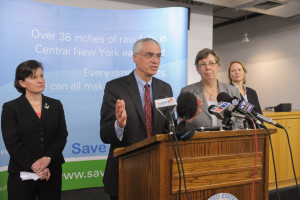The U.S. Environmental Protection Agency (EPA) has announced that Syracuse, New York has been chosen as one of 10 communities throughout the nation being recognized as a “Green Infrastructure Partner.” Green infrastructure projects use open space and natural areas, such as greenways, wetlands, parks, forests and native plant vegetation, to manage stormwater and reduce flooding. The selection of the partner cities was based on their success in implementing green techniques to manage stormwater, and in their progress in creating more sustainable, livable communities.
The Environmental Finance Center at SyracuseCoE CSCS is a key partner in the Save the Rain campaign, leading education and outreach efforts on green infrastructure in Onondaga County and the City of Syracuse.

“Onondaga County and the City of Syracuse have set a tremendous example for other communities looking to improve their water quality,” said EPA Regional Administrator Judith Enck. “Green infrastructure is a fiscally responsible answer to many urban water challenges, and helps build healthier communities. The investments that Syracuse and Onondaga County are making today will be a catalyst for sustainable growth for years to come.”
“I would like to thank EPA Administrator Lisa Jackson, Deputy Administrator Bob Perciasepe, and Regional Administrator Judith Enck for their leadership and support in promoting the use of Green Infrastructure throughout the nation. We are honored to be recognized by EPA as a Green Infrastructure Partnership Community and take very seriously our shared responsibility to ensure that the Save the Rain program serves as a national model for balancing the use of gray and green infrastructure in managing stormwater,” said Joanie Mahoney, Onondaga County Executive.
“I am thrilled that Syracuse and Onondaga County have been chosen by the EPA as one of only 10 Green Infrastructure Partnership Communities in the nation. This distinction is a testament to the Syracuse community’s dedication to environmental stewardship, and to County Executive Mahoney’s visionary leadership,” said Syracuse Mayor Stephanie A. Miner. “Onondaga County’s ‘Save the Rain’ initiative has presented our community with opportunities for improved environmental quality and opportunities to foster an even stronger working relationship between the City and County.”
Stormwater often carries chemicals and other debris into local water bodies, and can damage stream and lake ecosystems. In older cities such as Syracuse, combined sewer systems that carry sanitary sewage from homes and street runoff from storm drains, can overflow during periods of heavy rain, further contaminating local waterways. The traditional collection and treatment of stormwater water can be very expensive, and result in significant construction and operations costs for local communities. Green infrastructure usually costs less to install and maintain compared to traditional infrastructure. Examples of green projects include capturing rainwater through the use of green roofs, permeable pavements, preserving wetlands, rain gardens and other methods that put the collected water to productive use before it enters municipal wastewater treatment systems. In addition to contributing to more sustainable sewer and water systems, green infrastructure projects often provide communities with additional recreation space, revitalizing neighborhoods and enhancing property values.
Through its Green Infrastructure Partnership program, EPA will work with other federal agencies, state and local governments, tribes, municipalities, and the private sector to identify opportunities and provide technical assistance to communities implementing green approaches to control stormwater. To encourage municipalities to adopt green infrastructure solutions, EPA will focus on community partnerships, outreach and information exchange, financing, and capacity building.
The City of Syracuse and Onondaga County are planning to complete 50 green infrastructure projects in the Syracuse area this year under the banner of Onondaga County’s “Save the Rain” program. Projects under this program include those in the Harbor Brook area, which will use green infrastructure technologies to reduce stormwater runoff, and improvements to Syracuse’s Near West Side neighborhood, including the installation of green roofs, permeable pavements and urban gardens.
For more information on EPA’s green infrastructure agenda, visit: http://www.epa.gov/greeninfrastructure
